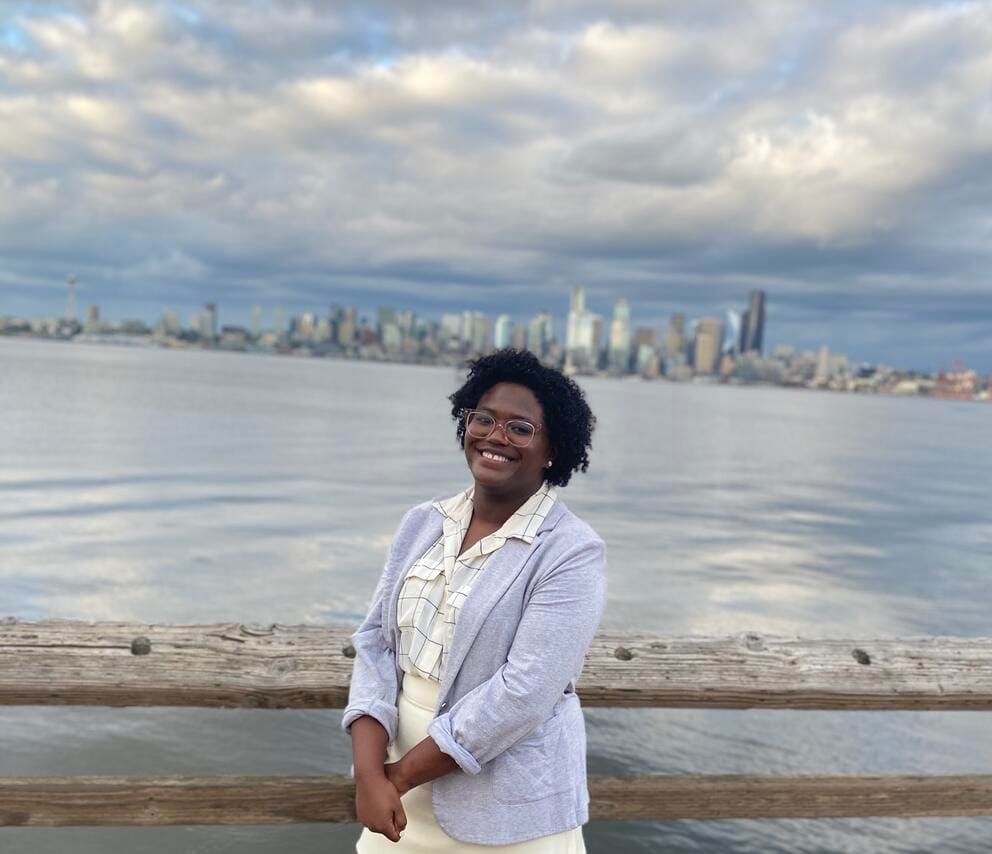As a public defense attorney in King County, Carnissa Lucas-Smith’s typical day often included a morning of court hearings – sometimes booked at the same time in different courtrooms – a quick lunch she worked through, followed by an afternoon in court for more hearings. Her packed days often meant prioritizing the most urgent issues – and sidelining the rest.
“There was so much pressure,” she said. “It just felt like I couldn’t do anything right. Because there was just so much going on and so little time to get everything done. I think it was hard to balance. Because whenever you’re working on one case, you’re taking time away from another case.”
Lucas-Smith left her position in July 2024 after four years because she said the number of cases made her workload untenable. At one point, she said, she had 170 cases – more than half the yearly limit.
“One thing that was difficult about the job for me was always wondering, ‘Is there more that I can do?’ But I just don’t have the time to do it all,” she said. “The pressure kind of got to me, and I think that it just was time for me to go.”
Many say public defense in Washington is in crisis – sparking a lawsuit over funding – as public defense attorneys throughout the state cite workloads as a key reason for leaving the profession. That’s part of why the Washington Supreme Court is now weighing new standards for defense attorney caseloads.
The existing standards limit a public defender to handling about 150 felony cases a year, which can include serious charges such as murder. A national study found the current standards allow an attorney about 14 hours on average for each felony case. Attorneys representing defendants on misdemeanor charges may handle a few hundred cases a year.
This story is part of Cascade PBS's WA Workplace Watch, an investigative project covering worker safety and labor in Washington state.
These standards were adopted in 1973 and haven’t been updated nationally since. Washington made a minor adjustment in 2012. But advances in technology, like the need to review video footage, make many cases more time-intensive than in decades past. The newly proposed standards would reduce that annual caseload cap by about 2/3 for felony cases and more than half for misdemeanor cases. The new standards would be phased in between now and July 2027.

Carnissa Lucas-Smith came back to her hometown of Seattle after law school to work as a public defender, but left after four years to work at a nonprofit. She said the volume of cases she was assigned played a role in her decision to leave. (Courtesy of Carnissa Lucas-Smith)
Proponents said the changes are a necessity for a number of reasons, including because public defense attorneys do not have enough time to adequately represent their defendants.
“Would you like to go to prison for your whole life because the public defender didn’t have enough time to research your case?” asked Larry Jefferson, director of the Washington Office of Public Defense.
Jefferson and others also said the current caseload demands can push attorneys to leave public defense during a time when many have said hiring attorneys – especially in the public sector – is already difficult.
At public hearings, opponents of the proposed standards have criticized the study used to determine the new caseload caps, saying that a national study does not factor in Washington’s distinct circumstances. However, the Washington State Bar’s Council on Public Defense – which proposed these standards to the state Supreme Court – worked to localize the study.
Opponents also questioned how cities and counties would shoulder millions of dollars in projected costs, how to recruit enough attorneys to meet the standards and the unknown implications for public safety.
Costs and ‘crisis’
Many cities and counties have raised public concern about covering the costs of the reduced caseloads. The proposal would require two to three times the current number of public defense attorneys as well as increase the number of support staff. That means cities and counties – which make up a majority of funding for local public defense – would need to cover the salaries of the additional attorneys.
Derek Young, interim executive director for the Washington State Association of Counties, said in a state Supreme Court hearing that the challenge of paying for public defense at the local level has worsened in recent decades.
“The public’s defense system is in crisis,” he said. “This is primarily due to funding.”
For example, the Stevens County Board of County Commissioners submitted a letter to the state Supreme Court outlining the estimated county costs. Commissioners wrote that by 2028 the public defense expenses will grow from the current cost of $1 million to $13 million. They noted the total expense budget for the county is about $26 million.
Young said the estimated statewide total cost to implement the new standards is about $1 billion. He said the biggest part of the issue is that funding of public defense comes primarily from the county level, with just 3% of funding coming from the state.
“I can assure you that we don’t have those kinds of resources,” he said in an interview. “At the county level, our taxes are capped.”
That’s why the WASC has filed a lawsuit against the state for a lack of funding, leading to a violation of constitutional rights for indigent defendants.

The state Supreme Court is considering revising caseload standards for defense attorneys following a national study that found that current standards do not account for advances in technology like the need to review video footage, making many cases more time-intensive than in decades past. (Jaelynn Grisso/Cascade PBS)
“This is a duty that we have, and it’s delegated in Washington almost entirely to the counties,” he said. “That creates a justice by geography, meaning that justice you receive in Washington depends largely on where you’re at. We think that for a fundamental right, that shouldn’t be allowed.”
Young said the goal is to create a state mandate for public defense similar to what the McCleary decision did for education. The lawsuit was filed in September 2023 but was initially dismissed by Thurston County Superior Court Judge Allyson Zipp because it was filed on behalf of counties rather than defendants.
For Jefferson, additional funding is necessary because the state has historically underfunded public defense.
“We’ve never fulfilled Gideon’s promise … that every poor person gets a public defender that’s properly trained,” he said. “We’ve never done that before. So this is our chance to do it.”
Jefferson said his office plans to make a historic budget request – totaling around $140 million as of early November – in the next legislative session.
Recruiting challenges
Both sides of the debate recognize that recruiting enough additional attorneys to match the proposed case limits could prove difficult, but proposal supporters argue that at current caseload levels, courts will continue to lose defenders, much less bring in new attorneys.
Jefferson said estimates suggest the state would need another 2,000 defense attorneys to meet the proposed standards. An average of 1,300 members are admitted to the bar in Washington each year, but typically only about 10% of attorneys go into the public sector, including both defense and prosecution.
“So, even if you had the money, which doesn’t exist there, also, it seems to be quite a stretch to suggest that the bodies are available or that the bodies are available where they would need to be if you were to impose this on a statewide basis,” said Russell Brown, executive director of the Washington Association of Prosecuting Attorneys.
High caseloads was a top reason public defenders left the profession, according to a survey conducted by the Office of Public Defense in April 2024. Jefferson said he believes reduced caseloads will help to recruit attorneys in Washington and nationally.
“We want to be a player nationwide,” he said. “I think if we pass these standards, it’s going to help us nationally in order to be able to recruit because they’re going to go, ‘Oh, wow, they don’t have a crushing, soul-crushing caseload.”
Austin Field, a public defense attorney for King County, said working as a public defender is the hardest job he’s ever done, including the 200-plus combat missions he led in Afghanistan. In short, the job has taken a toll, he testified to the state Supreme Court at a public hearing in September.
“I think we need to make something very clear today, and that’s that we aren’t really asking you for anything,” he said. “We are telling you the conditions we need to allow us to continue to do this job, and if you’re not willing to implement those conditions, then we’re no longer willing to do these jobs.”




